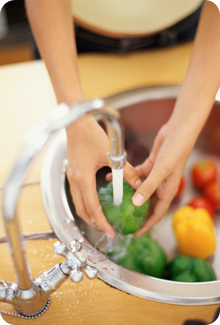Pesticides and food safety

To be healthy, we need to eat a variety of foods, especially fresh fruits and vegetables. Pesticides play an important role in making sure there is enough food for everyone, by protecting crops from pests like insects, weeds, and fungal diseases.
While pesticides help protect our food supply, some people have concerns about pesticide residue that may be on the food they eat.
Pesticide residue limits
After a pesticide is applied to a food crop, trace amounts of pesticide residues may stay in or on the food. Pesticides intended for use on food crops must be tested for the safety of these residues.
As part of the assessment process before a pesticide can be used on a food product, Health Canada scientists must study whether the pesticide residues that may be found in or on food will be a concern to human health, and determine the safe levels of residues, called Maximum Residue Limits, or MRLs.
Canadian MRLs are set for each pesticide and crop combination, for an approved pesticide use. Canadian MRLs:
- Are legally established as the highest amount of allowable residue
- Are set at levels far below the amount of pesticide residue that could cause health concerns
- Take into account all of the population including infants, children, and pregnant women
- Are set for all foods sold in Canada, whether produced locally or imported
- Apply to fruits, vegetables, meat, dairy products, grains, and some processed foods.
Is it safe to eat food treated with pesticides?
Maximum residue limits are regulated under the Pest Control Products Act. Establishing science-based MRLs helps ensure that pesticides are being used properly by growers, and provides Canadians with access to a safe food supply.
To ensure that Canada's MRLs are respected, both domestically produced food and imported foods are examined for pesticide residues. Imported foods must meet Canada's pesticide residue limits and are inspected at the point of entry into Canada.
Organic produce
Organic produce sold in Canada is subject to the Canadian Organic Standards.
Whether you eat organic or conventionally grown produce is a personal choice. To date, there is no scientific evidence to show that there is a health risk from eating conventionally grown produce because of pesticide residues, or that organic foods are safer to eat than conventionally produced foods.
Food safety in Canada
Food safety is a priority of the Government of Canada and is a shared responsibility between growers, industry, provinces, and federal organizations:
Health Canada:
- evaluates the health and environmental risks of proposed pesticides before they can be registered or used on foods
- provides food safety tips for all food types, and information on how to protect those who are vulnerable to food poisoning, food allergies and recalls
Agriculture and Agri-Food Canada and Health Canada work together on a number of programs that help provide safe food for Canadians, engage food producers in sustainable pest management practices and encourage environmental protection.
Food producers help keep food safe by using and improving on good agricultural, food safety, and sustainable pest management practices. This helps keep residues within the limits, helping ensure a safe food supply. The Canadian Food Inspection Agency enforces federal food safety regulations for both domestic and imported food. Inspectors sample domestic and imported foods for chemical residues and pesticide residues. If tested food products exceed limits, enforcement actions could include:
- removing the food from stores
- seizing food stocks
- rejecting imports
- prosecuting offenders
The Government of Canada makes sure producers properly use and apply pesticides and respect established residue limits.
Contact us
- For information about inspection, monitoring, and surveillance of food, contact the Canadian Food Inspection Agency at 1-800-442-2342.
- For information about agricultural practices, contact Agriculture and Agri-Food Canada at 1-613-759-1000.
- For information about pesticides, contact the Health Canada Pest Management Information Service at 1-800-267-6315.